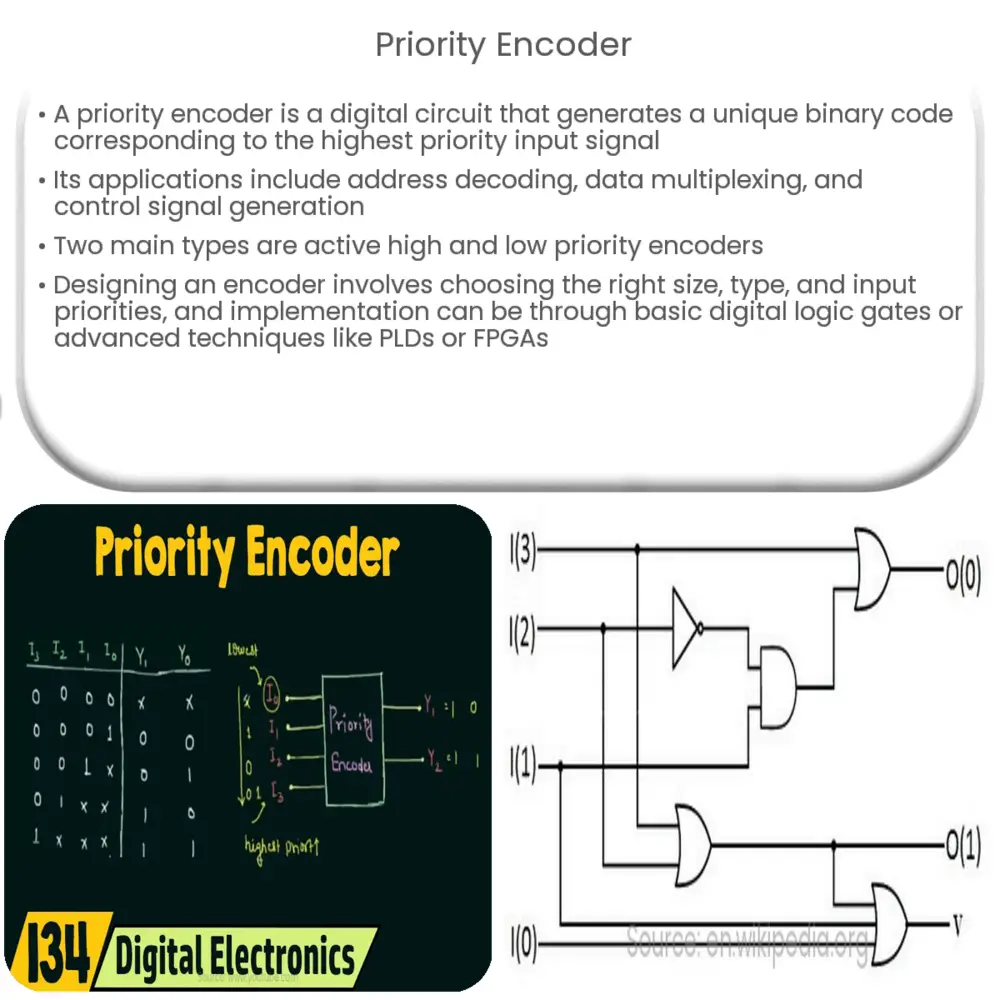A priority encoder is a digital circuit that converts multiple input signals into a unique binary code, representing the highest priority input.

Priority Encoder: A Comprehensive Introduction
What is a Priority Encoder?
A priority encoder is a combinational digital circuit that takes a set of input signals and generates a unique binary code that represents the highest priority input among them. It is widely used in digital systems for various purposes, including address decoding, data multiplexing, and control signal generation.
How Does a Priority Encoder Work?
Priority encoders assign a specific priority to each input line. When multiple input lines are active simultaneously, the priority encoder produces an output code corresponding to the input with the highest priority. For instance, in a 4-to-2 priority encoder with input lines A, B, C, and D, where A has the highest priority and D the lowest, if both A and C are active, the encoder will generate the code for A.
Priority encoders come in various sizes, depending on the number of input and output lines. Commonly used priority encoders are 4-to-2, 8-to-3, and 16-to-4. In general, an n-to-m priority encoder has n input lines and m output lines, with 2^m ≥ n.
Applications of Priority Encoders
Priority encoders have a wide range of applications in digital systems. Some of the most common uses include:
- Address Decoding: In memory address decoding, a priority encoder is used to convert a binary address into a unique code for accessing a specific memory location. This helps reduce the number of required address lines, simplifying the overall system design.
- Data Multiplexing: A priority encoder can be used to select one of multiple input data sources based on priority. This is useful in applications such as communication systems, where data from various sources need to be transmitted over a single channel.
- Control Signal Generation: In microprocessor-based systems, priority encoders are employed to generate control signals for various operations. For example, they can be used to identify interrupt requests with the highest priority, ensuring that critical tasks are executed before others.
Advantages and Limitations
Priority encoders offer several advantages, such as:
- Reduction in Complexity: By producing a unique code for each input, priority encoders help simplify the design of digital systems, reducing the number of components and interconnections.
- Efficient Priority Handling: Priority encoders ensure that the highest priority input is processed first, making them ideal for applications that require efficient priority management.
However, there are some limitations associated with priority encoders:
- Latency: The time it takes for the priority encoder to generate an output code depends on the input priorities, which may lead to latency in certain applications.
- Dependency on Input Priorities: The performance of a priority encoder relies on the correct assignment of input priorities, making it susceptible to errors if priorities are not properly assigned.
Types of Priority Encoders
There are two main types of priority encoders:
- Active High Priority Encoder: In an active high priority encoder, input lines are considered active when they have a high (logic 1) signal level. The output code represents the highest priority input that is at the active high state.
- Active Low Priority Encoder: In an active low priority encoder, input lines are considered active when they have a low (logic 0) signal level. The output code represents the highest priority input that is at the active low state.
Both types have their unique advantages and applications, depending on the requirements of the digital system in which they are employed.
Designing a Priority Encoder
Designing a priority encoder involves selecting the appropriate size, type, and input priorities based on the specific application requirements. Once these parameters are determined, the encoder can be designed using basic digital logic gates such as AND, OR, and NOT gates. Alternatively, more advanced design techniques like programmable logic devices (PLDs) or field-programmable gate arrays (FPGAs) can be used for a more flexible and efficient implementation.
Example: 4-to-2 Priority Encoder
Let’s take a closer look at a simple 4-to-2 priority encoder with input lines A, B, C, and D, where A has the highest priority and D the lowest. The output lines are Y1 and Y0. The priority encoder can be designed using the following logic equations:
Y1 = A + B'(C + D) Y0 = A + B
These equations can be implemented using a combination of AND, OR, and NOT gates. For example, the active high 4-to-2 priority encoder can be constructed using two OR gates, one AND gate, and two NOT gates.
Conclusion
Priority encoders are essential components in many digital systems, helping to reduce complexity and manage priorities effectively. By understanding their basic principles, types, and applications, engineers can design and implement priority encoders to meet the requirements of various digital systems. While priority encoders have some limitations, such as latency and dependency on input priorities, their benefits generally outweigh these drawbacks, making them a valuable addition to any digital designer’s toolbox.
